

|
|
|
|
|
There is a great new field guide: Branch (1998). It has distribution maps, lucid text, and color photos of all species. The revised edition I acquired over there had 83 new species added since the previous edition, so there has been a fair amount of recent taxonomic work on reptiles in southern Africa. [Those marked with an asterisk (*) were lifers for us; this was most of them!] |
 |
Chersina angulata * This was a common tortoise of the scrubby sand dunes in West Coast NP, a half-day's drive up the coast from Cape Town. We saw something like 30 (!) during our few hours; many smaller ones were crossing the road or seen at the road's edge. Unfortunately this was the only species we saw alive, A dead Tent Tortoise Psammobates tentorius was on the road enroute to Brandvlei. About 30% of the world's tortoises occur in southern Africa, and 12 species are endemic to this region. |
| Marsh Terrapin Pelomedusa subrufa * | The common and widespread African turtle of ponds and marshes was seen at a waterhole in Etosha NP, Namibia |
 |
|
Mabuya striata * A mid-sized stripey skink in Etosha NP and at Nkwasa Camp near Rundu (below left) was thought to be this widespread species on the basis of range and overall appearance. There are other 'striped' skinks but they seem to be more local and elusive. This species inhabits a wide range of habitats and is common around human habitation. It is possible that the lizard (below right) at the entrance to Mahango Game Reserve in the Caprivi Strip is also this species. Breeding males are said to have an orange-brown head with yellow-orange throat.
|
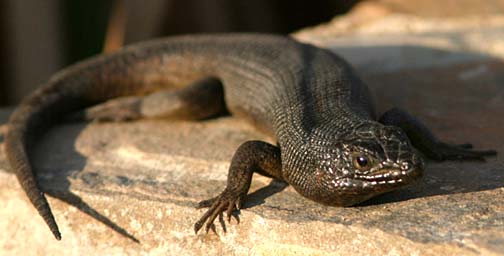 |
Mabuya sulcata * This medium-sized black skink (left) was photographed at Canyon Lodge in south Namibia. Another was seen at Anib Lodge in central Namibia. It is the males that can get all-black (although they are suffused with bronze in some populations). Females and young are dull olive. |
|
Pedioplanis namaquensis * These small (4-6 inch long) fast lizards were under very small bits of desert scrub at Spitzkoppe, and ran ahead of me as I chased down the Herero Chat. Branch (1998) says "These amazingly fast lizards can be seen in the heat of the day, dashing over open, sparsely vegetated sand and gravel flats." Although also said to be dormant in winter, this photo matches the species well. |
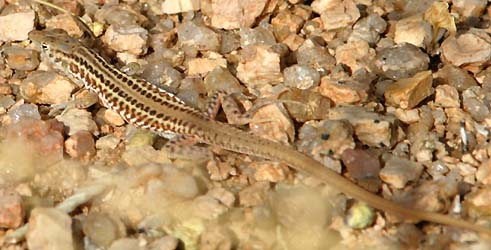 |
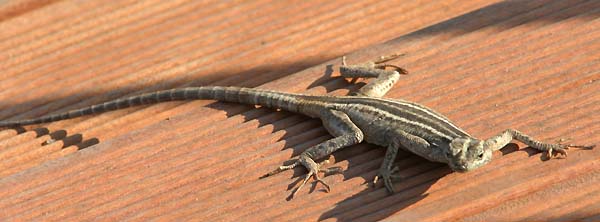 Broadley's
Flat Lizard Broadley's
Flat Lizard
Platysaurus broadleyi This lizard is endemic to a very short stretch of the Orange River in westernmost South Africa. Fortunately, this stretch of river include Augrabies Falls. As Branch (1990) says: "These beautiful lizards are common on the smooth granite walls of the Augrabies Falls." Males are colorful with dark blue throats, black bellies, and orange forelimbs. Alas, the only ones I got close to were the stripey females or young (left). Note the long toes for hanging on to vertical cliffs. |
| Cape Crag Lizard Pseudocordylus microlepidotus * | One was sunning outside our lunch restaurant at the Cape of Good Hope, but it scuttled away before I was able to retrieve my camera |
| Nile Monitor Varanus niloticus | Several slunk along the muddy banks of the Okavango River but dropped into the water when we got too close. |
|
or Etosha Agama Agama etoshae * This single small Agama was perched on this little boulder in central Etosha NP, and was photo'd out the car window. Etosha Agama has a tiny range: it is essentially endemic to Etosha park. Ground Agama has a much wider range throughout the interior of s.w. Africa. We wanted it to be the Etosha Agama but the photo in Branch (1998) looks better for Ground Agama — the Etosha Agama doesn't seem to be this patterned. Further, the 5th toe may be as long as the 1st toe (good for Ground) instead of very short (as in Etosha). This is probably Ground Agama but, either way, it is a lifer. |
 |
|
Agama planiceps * These colorful and very fast lizards were clinging to huge boulders around the base of Spitzkoppe. Females (below left) and youngsters were by far the majority of the 20+ seen; full males (below right) were scarce. The dominant male defends a territory that has a harem of females, and will not tolerate another male in its territory during the breeding season (Branch 1998). These are comparatively large lizards (two feet long in males) but also quite shy. It took significant effort to get these shots.
|
|
Lygodactylus ?? I didn't think this was a gecko when I took the picture — I labeled it "tree lizard" — but close examination seems to show gecko-like toe pads (blow-up of left front leg; below).  |
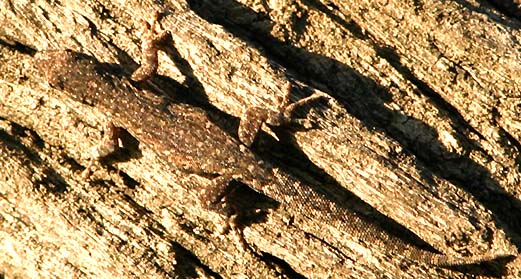 |
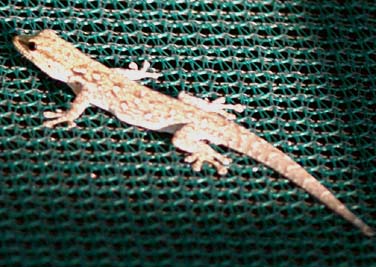 |
Lygodactylus chobiensis * This tiny gecko was on the woven shutters that fringed the sides of our individual bungalow at Xaro Camp in the Okavango Delta. Branch (1998) says they typically forage high in trees for ants and termites but are known to forage on houses. This i.d. is primary on range, behavior, and size. |
|
Crocodylus niloticus A few were seen daily on the Okavango River. At this high water stage there were not many sandbars, and thus the few we saw were hugging the river banks, tucked under cover, and not very large. But you don't want to swim in the Okavango . . . |
 |
| We also encountered a variety of other interesting plants and animals; shown below is an active paper-wasp nest at Spitzkoppe. Richard was very interested in wildflowers, and took a good selection of photos. I find I have enough trying to i.d. the birds, mammals, herps, and sharks we saw. But southwestern Africa is a spectacular part of this planet. |
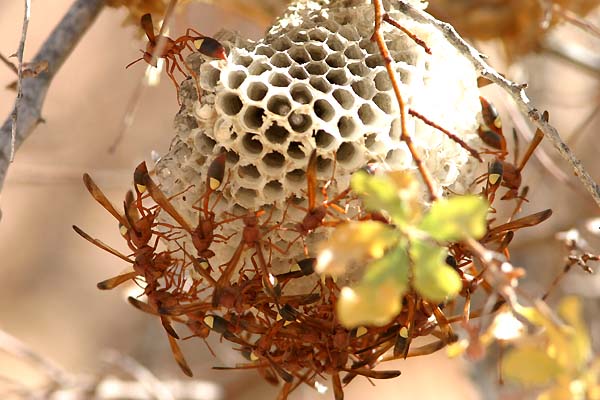
|
|
|
|
|
|
|
|
|
|
|
|
PHOTOS: All photos on this page are © 2005 Don Roberson; all rights reserved. Many other shots from this trip are scattered about this web site. Check particularly bird families, mammals, and herps listings.
Literature cited:
Branch, B. 1998. Field Guide to Snakes and other Reptiles of southern Africa. Rev. ed. Struik Publ., Cape TownTOP
GO TO LIST OF BIRD FAMILIES OF THE WORLD